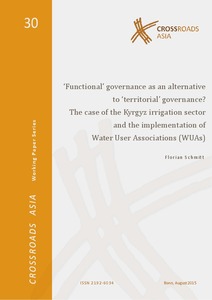‘Functional’ governance as an alternative to ‘territorial’ governance? The case of the Kyrgyz irrigation sector and the implementation of Water User Associations (WUAs)

‘Functional’ governance as an alternative to ‘territorial’ governance? The case of the Kyrgyz irrigation sector and the implementation of Water User Associations (WUAs)

| dc.contributor.author | Schmitt, Florian | |
| dc.contributor.editor | Baldauf, Ingeborg | |
| dc.contributor.editor | Conermann, Stephan | |
| dc.contributor.editor | Kreutzmann, Hermann | |
| dc.contributor.editor | Nadjmabadi, Shahnaz | |
| dc.contributor.editor | Reetz, Dietrich | |
| dc.contributor.editor | Schetter, Conrad | |
| dc.contributor.editor | Sökefeld, Martin | |
| dc.contributor.editor | Bech Hansen, Claus Erik | |
| dc.contributor.editor | Hornidge, Anna-Katharina | |
| dc.contributor.editor | Mielke, Katja | |
| dc.date.accessioned | 2016-10-06T12:40:53Z | |
| dc.date.available | 2016-10-06T12:40:53Z | |
| dc.date.issued | 08.2015 | |
| dc.identifier.uri | https://hdl.handle.net/20.500.11811/165 | |
| dc.description.abstract | International development organizations regard the concept of Integrated Water Resource Management (IWRM) as the universal model for participatory water governance and thereby globally promote the installation of so called Water User Associations (WUAs) for local irrigation management. As in most parts of Central Asia, WUAs have been introduced throughout Kyrgyzstan during the last two decades, too. The general idea of this approach is to solve the problem of deteriorating state-owned irrigation infrastructure through the transfer of irrigation responsibility and authority to the water users themselves. The long-term goal behind this is to transform the irrigation sector into a sustainable, market-friendly and democratic system. However, the performance of irrigation management systems in Kyrgyzstan is on average still very low and they can usually not provide equitable water withdrawal. There are almost no self-supporting WUAs and a large share of them is highly indebted (World Bank 2014: 15; Sehring 2009: 132-133). Using the example of Kyrgyzstan’s irrigation sector, this paper makes a theoretical attempt to show that a main cause for the malfunction of WUAs in a developing country is their blueprint governance design, which often disregards the socio-political context in which irrigation systems are embedded. Referring to Hooghe and Marks’ (2003) dualistic typology of Multi-Level-Governance (MLG), I assert that the WUA approach in Kyrgyzstan largely coincides with ‘territorial governance’, whereas WUAs ideally rather match with ‘functional governance’ arrangements and that this is a cause for inefficiencies and low performance in the Kyrgyz irrigation sector. On these grounds this study addresses the following two research questions: To what extent can the way of forming local governance structures be described as a reason for the low performances and current challenges in the Kyrgyz irrigation sector? Is functional governance (MLG type II) a better alternative to territorial governance of local irrigation systems (MLG I) in Kyrgyzstan? | en |
| dc.format.extent | 33 | |
| dc.language.iso | eng | |
| dc.relation.ispartofseries | Crossroads Asia Working Paper Series ; 30 | |
| dc.rights | In Copyright | |
| dc.rights.uri | http://rightsstatements.org/vocab/InC/1.0/ | |
| dc.subject.ddc | 320 Politik | |
| dc.title | ‘Functional’ governance as an alternative to ‘territorial’ governance? The case of the Kyrgyz irrigation sector and the implementation of Water User Associations (WUAs) | |
| dc.type | Arbeitspapier | |
| dc.publisher.name | Competence Network Crossroads Asia: Conflict – Migration – Development | |
| dc.publisher.location | Bonn | |
| dc.rights.accessRights | openAccess | |
| dc.relation.eissn | 2192-6034 | |
| dc.relation.url | http://crossroads-asia.de/veroeffentlichungen/working-papers.html | |
| ulbbn.pubtype | Zweitveröffentlichung |
Dateien zu dieser Ressource
Das Dokument erscheint in:
-
Crossroads Asia Working Paper Series (37)
Working Paper des Kompetenz-Netzwerks Crossroads Asia




